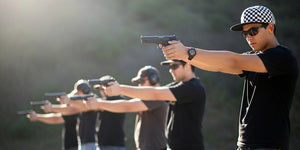Why step into a pistol shooting competition of any type? Three reasons:
First, it makes you a better shooter. Second, it builds confidence under pressure and teaches you how to manage nerves. And third—it’s just plain fun. You get to test yourself and share great times with fellow shooters.
As we explore the most popular pistol shooting sports—like USPSA, IDPA, IPSC, Steel Challenge, and 3-Gun—you’ll start to see which format feels like the perfect fit. And you’ll also get a sense of whether you should lean toward a race gun or a tactical setup.
In this guide, we’ll break down the major pistol shooting competition types, explain scoring systems and stages, and show how each discipline tests different skills. Because it’s not the same to compete for tactical precision as it is for pure accuracy and speed.
Whether you’re jumping into a local shooting match for fun or setting your sights on the nationals, there’s a competition style out there for you. Let’s find out which one fits best.
USPSA
If you’ve spent any time around pistol shooting sports, you’ve heard of USPSA—the United States Practical Shooting Association. These matches are fast-paced action with plenty of variety. Every stage is against the clock, with dynamic targets, stage planning, and obstacles that keep you on your toes.
USPSA matches are a mix of speed, accuracy, and strategy. It’s one of the most exciting and popular handgun competition formats out there.
USPSA is the U.S. branch of IPSC and currently has over 37,000 active members. While it’s highly competitive at the championship level, local matches are very welcoming. You’ll see everything from first-timers just learning the ropes, to weekend regulars, to seasoned pros chasing national titles.
Gear is a big part of the fun here. USPSA matches have eight divisions: Open, Limited, Limited 10, Production, Single Stack, Revolver, Carry Optics, and Pistol Caliber Carbine. Carry Optics has become the most popular, while the Open division is where the true “race guns” live: compensators, extended mags, red dots, and more.
How do USPSA matches work? Scoring is based on the Hit Factor (HF):
Hit Factor (HF) = (Points Scored – Penalties) ÷ Time
Your final score depends on how many points you land (A, C, and D zones), minus penalties for misses or rule infractions, all divided by your time. The shooter with the highest Hit Factor on a stage gets 100% of the stage points.
In other words, USPSA rewards the perfect balance of accuracy and speed—exactly the challenge most shooters crave.
IPSC
Next, let’s level up and go beyond the nationals. USPSA is the American regional body, but at the international stage, you’ll find IPSC—the International Practical Shooting Confederation. It’s the global version of practical shooting, with matches held all over the world.
So if you’re up for IPSC matches, you need to be really good at two things: shooting, and packing for worldwide travel.
At first glance, IPSC looks a lot like USPSA. Both are high-energy shooting disciplines built around movement, accuracy, and stage planning. But there are some key differences. USPSA matches often push raw speed and performance, while IPSC competitions tend to be more technical, with stage designs that include tighter shooting angles and varied target presentations.
Another difference is gear and round limits. IPSC keeps things a bit stricter:
-
Magazine capacity: capped at 15 rounds for most divisions.
-
Open division: allows compensators, optics, and extended magazines, but mags are limited to 170mm compared to USPSA’s 171.25mm.
-
Standard & Production divisions: popular worldwide but much stricter when it comes to gear.
Stage design in IPSC is also more standardized. Matches follow strict ratios of short, medium, and long courses, which makes the shooting challenges more consistent from one country to another.
When it comes to scoring, IPSC uses Comstock only. That means no Virginia Count or Fixed Time stages like you sometimes see in USPSA. IPSC stages never limit the number of shots or have fixed time caps—you just shoot as accurately and quickly as you can, and the best balance wins.
If USPSA is your local proving ground, IPSC is where you step up to see how your skills measure up on the global stage.
IDPA
If you lean more toward tactical shooting than race guns, IDPA might be your favorite pistol shooting sport. The IDPA (International Defensive Pistol Association) is all about practical, real-world scenarios. It’s still a competition, but the rules are stricter than USPSA: no wild race-gun setups or flashy mods here.
The idea behind IDPA matches is simple: test your defensive skills under pressure. Stages are designed around realistic situations like drawing from concealment, shooting from cover, or reloading behind a barrier.
Gear rules reflect that philosophy. Most stages cap magazine capacity at 10 rounds. Compensators, ported barrels, and race optics are not allowed. You’re expected to run your pistol much like you would in a defensive carry setup.
Still, the Enhanced Service Pistol (ESP) division gives you a little more flexibility than Stock Service Pistol (SSP). But even then, comps and muzzle brakes are off the table.
When it comes to USPSA vs IDPA, the difference is clear. USPSA matches are more about speed and performance gear. On its side, IDPA keeps you grounded, testing how well you can shoot under pressure with a simpler setup.
If you’re brand-new to shooting, IDPA might not be the best place to start. You’ll want a solid baseline first—safe trigger discipline, smooth holster draws, and a reliable master grip.
Steel Challenge

Steel Challenge is the pure speed test of shooting sports—fast draws, split-second accuracy, and no room for mistakes. The challenge is simple: shoot fast, hit your targets, and don’t miss.
The SCSA (Steel Challenge Shooting Association) is a member organization of USPSA. Their matches feature eight official stages, and almost all of them are stationary. You can compete with rimfire or centerfire handguns, and even rifles. If you want to run a compensator or optics, that puts you in the Open division.
So what does a stage look like? Each one has five steel targets in different shapes. One plate is painted red as the stop plate. On the buzzer, your job is to hit all five targets as quickly as possible, finishing on the stop plate.
In Steel Challenge, your enemy is the clock. Scoring keeps things straightforward:
-
Each stage is shot in five strings of fire.
-
Your slowest run is dropped.
-
The remaining four times are added together for your final stage score.
-
Misses cost you: every target left standing adds a +3 second penalty to your time.
That makes Steel Challenge the ultimate test of raw speed and precision. You can’t afford sloppy misses, but you also can’t hesitate. Among the different types of gun competitions, it’s the one that puts your reflexes and accuracy to the test in the clearest way.
3-Gun Competition
If USPSA feels like a sprint, 3-Gun is the X Games of shooting sports. It’s fast, adrenaline-packed, and built for variety. As the name says, you’ll run three platforms—rifle, handgun, and shotgun—in the same stage.
To compete in 3-Gun competitions, you’ll need more than accuracy. You’ll need to move quickly, transition between guns under pressure, and adapt to creative stages filled with obstacles, mixed targets, and varying distances.
If you’re great with your favorite pistol, that alone won’t make the cut here. In 3-Gun matches, you need to master all platforms.
So what gear do you need? At minimum: a semi-auto rifle, a reliable handgun, and a shotgun. From there, divisions break things down:
-
Tac Ops: The most popular division. Handgun compensators aren’t allowed, but rifles can run them.
-
Open Division: The true race-gun category. Compensators, optics, and extended gear are all on the table.
-
Limited Division: The stripped-down option. Gear across all three platforms is close to stock.
3-Gun stages flow differently than other shooting disciplines. You’ll move through a course of fire, transitioning from rifle to shotgun to pistol; or maybe the other way around.
This is really the competition for versatile shooters. And don’t forget the supporting gear—belts, mag holders, and pouches all count when you’re racing the clock. Among the many types of gun competitions, 3-Gun is the one that proves how complete your skill set really is.
How to Choose the Right Pistol Competition
Do you need to buy all the gear right away? Absolutely not. The right gear definitely helps as you progress, but in the beginning, all you really need is the basics required for the division you want to enter.
If there’s one thing you do need from the start, it’s humility. Especially in your first matches. Chances are, you’re not going to win right away—and that’s okay. What matters is showing up, learning the ropes, and not being afraid to take your shots. Once you’re in, the real rewards come: steady progress in marksmanship, and the pure fun of competition.
And when you’re ready to take things to the next level, the right pistol can make a big difference. Here are our top picks:
Best Race Gun Pick
Canik SFx Rival – A true competition-ready pistol you can take straight from the box to the match. Shooters love its crisp trigger with a short reset, long slide, 5" barrel, and excellent grip texture—everything you want from a race gun.
It’s optic-ready, ships with extended magazines and adjustable sights, and fits right into divisions like USPSA Carry Optics, Open, or even IPSC Production Optics. Want to make it even faster and flatter? Pair it with our SFx Rival compensator, which cuts recoil by up to 60%. That’s the kind of edge that turns a good run into a great one.
Best Tactical Competition Pistol
Canik TP9 Elite Combat – NATO-approved and rigorously tested for combat scenarios, this pistol is built tough. It balances compact handling with a 15-round magazine, a 4.73" threaded barrel, and fiber optic sights from Salient Arms. Plus, it’s optics-ready, making it versatile, when you need it.
If you’re eyeing IDPA divisions, the TP9 Elite Combat is a fantastic fit. Some divisions restrict compensators, yes. But when you get the chance, add our TP9 Elite Combat compensator, and you’ll tame recoil and sharpen precision like no other.
Ready to Compete?
So, what’s next? The best way to start is simple: head to a local USPSA match. Most clubs run them on weekends, and sometimes weeknights. You’ll usually find 20–50 shooters, people just like you, from first-timers to regulars.
From there, you can set your sights on the majors. These are the bigger matches that bring in shooters from across the country.
But if you want to try other pistol shooting sports, going tactical is always a good option. Steel Challenge and IDPA both push you further, make you shoot better, no matter the scenario. It takes training, but the payoff is worth it.
Whatever route you take, now you know the types of gun competitions out there and the gear that can help you shine.
So grab your pistol, check the match calendar, and when you’re ready to level up, make sure you’ve got a 45 Blast compensator on your side. Faster, flatter, and ready for your best run yet.


